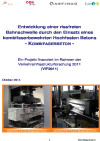Combined fibre concrete – Development of a crack-free railway sleeper through the use of a combined fiber-reinforced high-strength concrete
Short Description
Starting point / motivation
As part of the railway superstructure, the sleeper has the task, to transfer the strain of the rail track to the foundation and to ensure the compliance of the track gauge. In addition, they must be sufficient dimensionally accurate, resist to the weather conditions and low-priced in maintenance.
In addition to wooden, steel and plastic sleepers there are also commonly used prestressed concrete sleepers. In the practical application often cracks occurs at prestressed concrete sleepers. The reason for that are often faults in the manufacture, such as the application of the pre-stressing force at still insufficient strength of the concrete or an inadequate mix recipe itself.
The crack types, e.g. longitudinal, lateral and shrinkage cracks are differed principally between macro cracks due to insufficient bearing capacity or an inadequate behaviour of fatigue and micro cracks due to shrinkage deformations. All types of cracks reduce the impermeability of the concrete significantly, thereby the resistance respect to environmental influences is lowered and accordingly a significant decrease of lifetime is assumed.
Contents and goals
By using a newly developed combined fibre-reinforced high-strength concrete, it was attempted to reduce the risk of crack formations significantly. It was used in combination so-called micro fibres to reduce shrinkage cracks and macro fibres to reduce the risk of cracking because of structural reasons. By reducing the risk of cracks the increasing of lifetime of concrete sleepers was expected, which in turn would reduce the costs of maintenance.
Results and Conclusion
A dynamic stress test was carried out with excellent results in terms of cracking-behaviour (first and follow-up crack) of the conceived combined fibre concrete. The test also pointed out that the preload force has an important impact on the carrying capacity of the analysed concrete sleepers.
Therefore the developed combined fibre concrete showed within a small scale test, that a greater carrying capacity is possible with a lessened preload force. Whether and to which extent this can be applied / implemented in practice has to be explored in further real scale assessments of concrete sleepers.
Publications
Combined fibre concrete – Development of a crack-free railway sleeper through the use of a combined fiber-reinforced high-strength concrete

In practice the use of pre-stressed concrete sleepers is often accompanied by cracks-occurrence, such as longitudinal, lateral and shrinkage cracks. At the occurrence of cracks the resistance of sleepers to environmental influences is reduced.By the development of a combined fibre reinforced high-strength concrete, the risk of a formation of micro- and macro cracks can be substantially reduced, whereby the expected lifetime of concrete sleepers can increasing significantly and a costly renovation can be avoided.
Dr.- Ing. Sandro Weisheit, Dipl.-Ing. Gregor Metzler
Publisher: BMVIT
German, 85 Seiten
Publication Downloads
Project Partners
Project management
Dr.-Ing. Sandro Weisheit, University Innsbruck - Institute for construction and materials sciences
Contact Address
University Innsbruck - Institute for construction and materials sciences
Dr.-Ing. Sandro Weisheit
Tel.: +43 (512) 507-6890
E-mail: sandro.weisheit@uibk.ac.at
